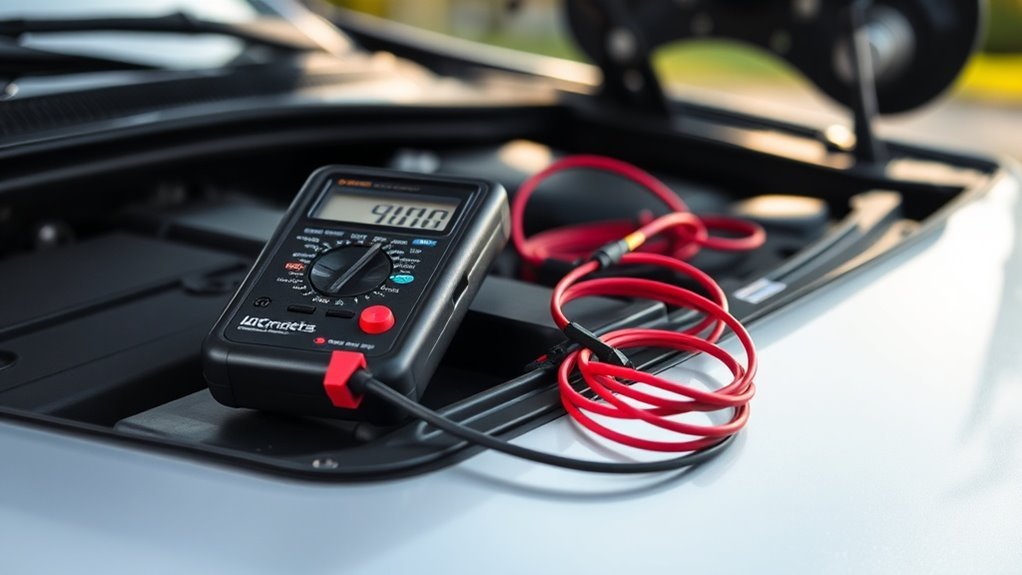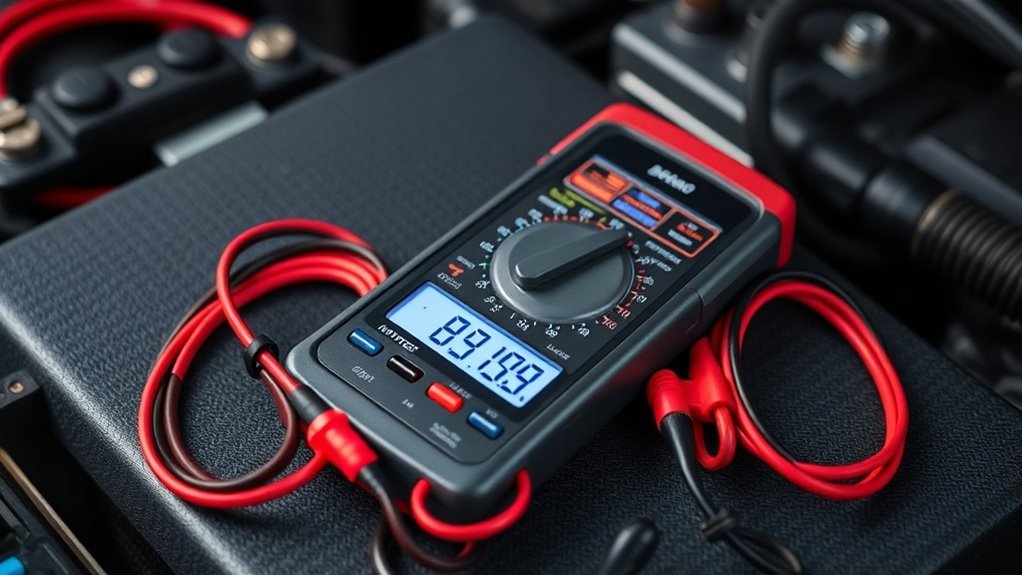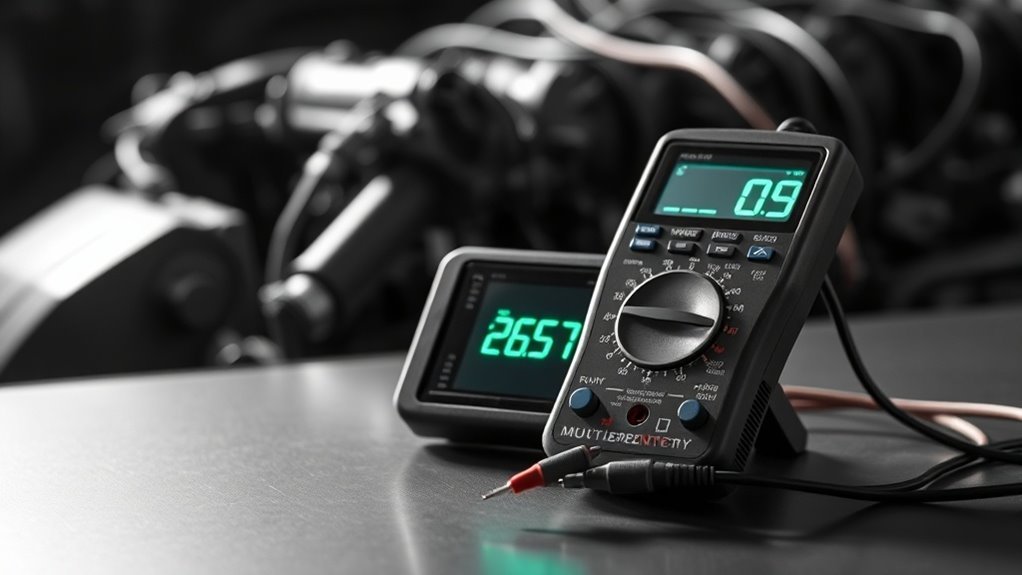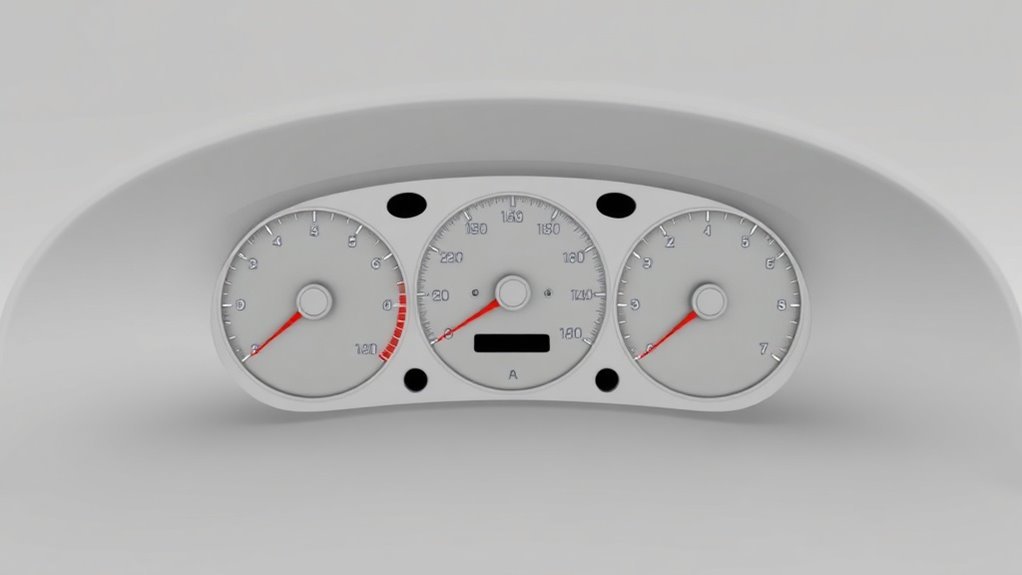The Role of Multimeters in Automotive Diagnostics

Multimeters play an essential role in automotive diagnostics by accurately measuring voltage, current, and resistance in vehicle electrical systems. You can troubleshoot issues like faulty sensors, battery problems, and wiring faults with ease. By using a multimeter, you can pinpoint electrical problems that aren’t visible with just a visual inspection. Plus, understanding how to interpret your readings effectively can save you time and prevent costly repairs. There’s plenty more to explore about their features and applications.
Key Takeaways
- Multimeters help diagnose electrical issues in vehicles by measuring voltage, current, and resistance accurately.
- Voltage measurements assess battery health and electrical systems, crucial for efficient vehicle operation.
- Resistance testing evaluates components like sensors and wiring, identifying faults unseen by other diagnostic methods.
- Current measurements are essential for troubleshooting malfunctions and ensuring proper circuit function.
- Regular use of multimeters facilitates proactive maintenance, preventing costly repairs and enhancing vehicle reliability.
Understanding Multimeters: Types and Functions
Multimeters are essential tools in automotive diagnostics, simplifying the process of measuring electrical values. You’ll find two main types: digital and analog.
Digital multimeters (DMMs) are widely used for their ease of readout and accuracy, while analog meters, though less common, offer a real-time view of changing values through a needle. Understanding their functions is fundamental.
A multimeter can measure voltage, current, and resistance, which are critical for diagnosing electrical issues in vehicles. Additionally, some advanced multimeters provide specialized functions such as data retention and auto-ranging, catering to a mechanic’s specific needs.
Essential Features of a Multimeter for Automotive Use

When you’re choosing a multimeter for automotive diagnostics, certain features are essential.
You’ll want to look for solid voltage measurement capabilities, resistance and continuity testing, and functions for diode and frequency measurements.
These aspects can make a significant difference in your troubleshooting efficiency. Additionally, understanding the difference between digital and analog multimeters can help you select a tool that best meets your diagnostic needs.
Voltage Measurement Capabilities
Having reliable voltage measurement capabilities is essential for effective automotive diagnostics. When you’re troubleshooting electrical issues, you need to accurately measure both AC and DC voltages.
A good multimeter should provide a wide range of voltage settings, allowing you to detect issues in various components, from batteries to sensors. Look for a multimeter with a minimum range of 0 to 60 volts to cover most automotive applications.
Additionally, features like auto-ranging can save you time and effort by automatically adjusting to the voltage level you’re measuring. Make certain it has a clear, backlit display for easy readability, especially in dimly lit engine bays.
With accurate voltage readings, you’ll enhance your diagnostic skills and guarantee your vehicle performs at its best.
Resistance and Continuity Testing
To effectively diagnose electrical problems in vehicles, resistance and continuity testing is an essential feature in any automotive multimeter. This functionality helps you determine if wiring, components, and circuits are working properly. By measuring resistance, you can find short circuits, open circuits, or faulty connections that might cause issues.
Continuity testing is vital for verifying the integrity of electrical paths; if a circuit isn’t continuous, it’s likely broken or damaged.
When using your multimeter for these tests, make certain to select the appropriate setting and verify the circuit is de-energized for safety. A reliable multimeter will provide accurate readings, helping you pinpoint problems efficiently, which ultimately saves you time and enhances the overall diagnostic process in automotive repair.
Diode and Frequency Functions
One of the key capabilities of a good automotive multimeter is its ability to test diodes and measure frequency. When you’re troubleshooting electrical issues, testing diodes guarantees they’re functioning properly and allows current to flow in one direction only. This is vital for components like rectifiers in charging systems.
A multimeter’s diode function typically shows the forward voltage drop, making it easy for you to spot faulty diodes.
Additionally, measuring frequency is fundamental for diagnosing issues in ignition systems and other components that operate with pulsating signals. With the frequency measurement function, you can verify signal integrity and timing.
Measuring Voltage: Techniques and Best Practices

Accurate voltage measurement is essential for diagnosing automotive electrical issues effectively. To measure voltage, start by selecting the appropriate DC or AC setting on your multimeter, depending on the circuit you’re testing.
Accurate voltage measurement is crucial for effectively diagnosing automotive electrical problems. Select the right multimeter setting for optimal results.
Connect the black lead to the negative terminal and the red lead to the positive terminal of the component or circuit. Always verify you’re making contact with metal surfaces for accurate readings. If you’re measuring voltage in a live circuit, be cautious; don’t let the probes touch each other.
Record the reading promptly, and compare it against the manufacturer’s specifications. If you’re seeing unexpected results, it may indicate a fault in your electrical system. Using proper tools like circuit testers for verification can further ensure you’re diagnosing accurately.
Practicing these techniques will enhance your diagnostic skills and boost your confidence in troubleshooting automotive issues.
Current Measurements: How to Accurately Diagnose
Understanding voltage measurements sets the stage for diagnosing current issues in automotive systems.
To accurately measure current, you’ll need to set your multimeter to the appropriate amperage setting and guarantee it’s placed in series with the circuit. This means disconnecting the circuit and integrating the multimeter as a pathway for the current. Always be cautious; incorrectly connecting the multimeter can blow a fuse or damage the device.
When measuring current, you’re looking for fluctuations that might indicate a malfunction in components like the starter or alternator. Accurate readings help uncover problems, such as excessive draw or intermittent faults. Additionally, using a multimeter effectively can significantly enhance your ability to troubleshoot more complex electrical issues.
Regular practice and familiarity with your multimeter will enhance your diagnostic skills and guarantee you address current-related issues effectively.
Resistance Testing: Key Applications in Vehicle Systems
While you’re diagnosing vehicle systems, resistance testing plays an indispensable role in identifying faults that may not be easily observable through voltage or current measurements.
By checking the resistance of components, you can find issues in sensors, switches, and wiring. For instance, measuring the resistance of a temperature sensor can help determine if it’s functioning correctly. Likewise, testing a relay’s coil resistance can reveal if it’s faulty.
It’s vital to compare the measured resistance with factory specifications to guarantee accuracy. If you spot a significant deviation, that’s a strong indicator of trouble.
Common Electrical Problems and Multimeter Solutions
When you’re troubleshooting common electrical issues in your vehicle, a multimeter becomes your best friend. It can help you test battery voltage levels to guarantee your car has the power it needs, and diagnose sensor problems that might be causing irregular performance. Understanding how to use this tool effectively can save you time and money in repairs. Additionally, mastering continuity testing can further enhance your diagnostic skills, ensuring that electrical pathways in your vehicle are intact and functional.
Testing Battery Voltage Levels
Often overlooked, battery voltage testing is an essential step in diagnosing common electrical problems in vehicles.
With a multimeter, you can easily check the voltage levels of your car’s battery, ensuring it’s providing enough power.
Start by setting your multimeter to the DC voltage setting, then connect the red probe to the positive terminal and the black probe to the negative terminal of the battery.
A healthy battery should show around 12.6 volts when fully charged.
If it’s below 12.4 volts, your battery might be weak or discharged.
If you’re reading below 12 volts, it’s time to assess charging or replacing the battery.
Regular voltage checks can prevent headaches down the road and keep your vehicle running smoothly.
Diagnosing Sensor Issues
Sensor issues can be a major culprit behind many automotive electrical problems, affecting everything from engine performance to fuel efficiency.
Using a multimeter, you can diagnose these issues efficiently. Here are some common problems you might encounter:
- Faulty oxygen sensors: Bad readings can lead to poor fuel efficiency.
- Malfunctioning temperature sensors: Incorrect temperatures can affect engine timing.
- Defective mass airflow sensors: These can disrupt engine air and fuel mixtures.
- Broken throttle position sensors: They can cause inconsistent engine performance.
- Damaged transmission speed sensors: These impact shifting and overall transmission function.
With a multimeter, checking resistance, voltage, and continuity can help pinpoint the problem, saving you time and money on unnecessary repairs.
Safety Precautions When Using Multimeters in Vehicles
Although you may feel confident using a multimeter, it’s essential to observe safety precautions to prevent accidents or damage to your vehicle.
Always start by ensuring your multimeter is set to the correct mode and range. When working on vehicles, keep in mind that some components may remain live even when the ignition is off.
Avoid direct contact with moving parts and high-voltage areas. Wear safety goggles and insulated gloves as an extra layer of protection.
Make sure your multimeter leads are in good condition—damaged leads can cause short circuits or inaccurate readings.
Finally, disconnect the battery before working on electrical systems to reduce the risk of shocks.
Following these safety guidelines will keep both you and your vehicle safe.
Interpreting Multimeter Readings: A Guide
Understanding how to interpret multimeter readings is essential for effective automotive diagnostics. The readings you get can dramatically impact your troubleshooting process. Here are some key points to keep in mind:
- AC vs. DC Voltage: Know which type you’re measuring; cars mostly use DC.
- Resistance Readings: Check for continuity or shorts by measuring resistance.
- Current Flow: Learn how to measure current draw without damaging components.
- Frequency Readings: Essential for diagnosing electrical components that work at varying frequencies.
- Scale Selection: Always choose the right scale on your multimeter for accurate readings.
With practice and attention to detail, you’ll become adept at interpreting these readings, allowing you to diagnose issues with confidence.
Tips for Maintaining Your Multimeter for Longevity
To guarantee your multimeter lasts as long as possible, regular maintenance is key. First, keep it clean by wiping the casing and screen with a soft cloth. Dust and dirt can interfere with readings.
Next, check the battery often. Replace it promptly to avoid leakage, which can damage your device. Be careful with the probes; inspect them for wear and tear, and replace them if they’re frayed.
When you’re not using your multimeter, store it in a protective case to shield it from impacts. Additionally, avoid exposing it to extreme temperatures or humidity, as these can affect its performance.
Questions
Can I Use a Multimeter on Hybrid or Electric Vehicles?
Yes, you can use a multimeter on hybrid or electric vehicles. Just guarantee it’s rated for the voltage levels these vehicles operate at, and follow safety precautions to prevent accidents or damage to your equipment.
How Do I Choose the Right Multimeter for My Needs?
Sure, you could pick any multimeter, but why not choose wisely? Focus on features like accurate readings, true RMS, and durability. Consider your specific needs, and you’ll find the perfect match for your projects.
What’s the Difference Between Analog and Digital Multimeters?
Analog multimeters use a moving needle to display readings, offering a visual representation of changes. Digital multimeters provide numerical readouts, often more precise and easier to read. You’ll appreciate the clarity of digital for troubleshooting tasks.
Are There Any Multimeter Brands That Are Particularly Reliable?
Brands like Fluke and Klein Tools are known for their reliability. While there are many options, these are nearly bulletproof, ensuring you’ve got the support you need for your measurements every time.
How Can I Troubleshoot a Faulty Multimeter?
To troubleshoot a faulty multimeter, start by checking the batteries and fuses. Inspect the leads for damage. If it still doesn’t work, try resetting it or consult the manual for specific troubleshooting tips.
Conclusion
Ultimately, multimeters are essential tools for automotive diagnostics, enhancing your troubleshooting skills and helping you save time and money. Did you know that about 30% of vehicle issues are electrical in nature? By mastering measurements of voltage, current, and resistance, you can effectively tackle these problems. Always remember to follow safety precautions and maintain your multimeter for longevity. With the right techniques, you’ll become more confident in diagnosing and fixing automotive electrical issues efficiently.






